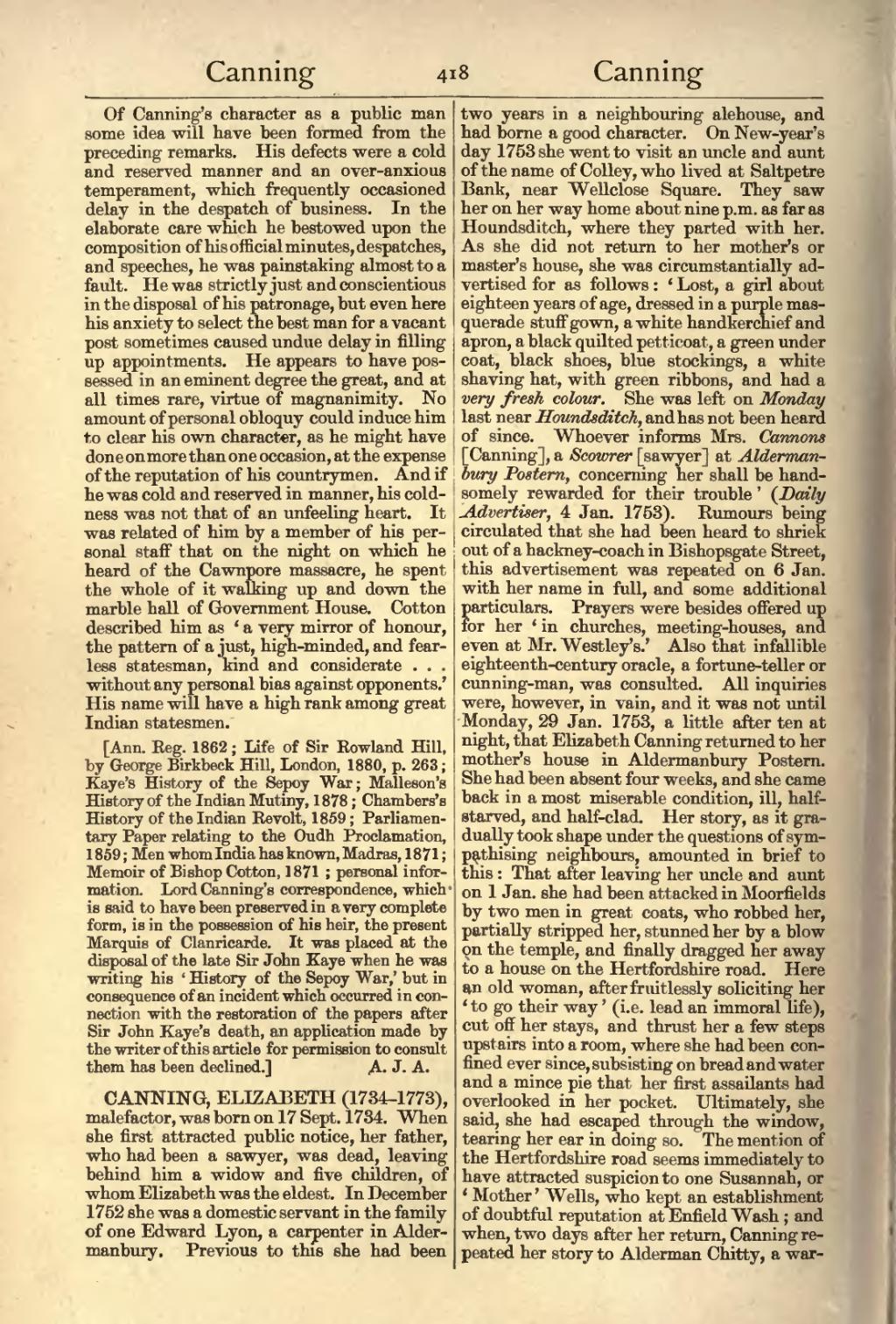Of Canning's character as a public man some idea will have been formed from the preceding remarks. His defects were a cold and reserved manner and an over-anxious temperament, which frequently occasioned delay in the despatch of business. In the elaborate care which he bestowed upon the composition of his official minutes, despatches, and speeches, he was painstaking almost to a fault. He was strictly just and conscientious in the disposal of his patronage, but even here his anxiety to select the best man for a vacant post sometimes caused undue delay in filling up appointments. He appears to have possessed in an eminent degree the great, and at all times rare, virtue of magnanimity. No amount of personal obloquy could induce him to clear his own character, as he might have done on more than one occasion, at the expense of the reputation of his countrymen. And if he was cold and reserved in manner, his coldness was not that of an unfeeling heart. It was related of him by a member of his personal staff that on the night on which he heard of the Cawnpore massacre, he spent the whole of it walking up and down the marble hall of Government House. Cotton described him as ‘a very mirror of honour, the pattern of a just, high-minded, and fearless statesman, kind and considerate … without any personal bias against opponents.’ His name will have a high rank among great Indian statesmen.
[Ann. Reg. 1862; Life of Sir Rowland Hill, by George Birkbeck Hill, London, 1880, p. 263; Kaye's History of the Sepoy War; Malleson's History of the Indian Mutiny, 1878; Chambers's History of the Indian Revolt, 1859; Parliamentary Paper relating to the Oudh Proclamation, 1859; Men whom India has known, Madras, 1871; Memoir of Bishop Cotton, 1871; personal information. Lord Canning's correspondence, which is said to have been preserved in a very complete form, is in the possession of his heir, the present Marquis of Clanricarde. It was placed at the disposal of the late Sir John Kaye when he was writing his ‘History of the Sepoy War,’ but in consequence of an incident which occurred in connection with the restoration of the papers after Sir John Kaye's death, an application made by the writer of this article for permission to consult them has been declined.]
CANNING, ELIZABETH (1734–1773), malefactor, was born on 17 Sept. 1734. When she first attracted public notice, her father, who had been a sawyer, was dead, leaving behind him a widow and five children, of whom Elizabeth was the eldest. In December 1752 she was a domestic servant in the family of one Edward Lyon, a carpenter in Aldermanbury. Previous to this she had been two years in a neighbouring alehouse, and had borne a good character. On New-year's day 1753 she went to visit an uncle and aunt of the name of Colley, who lived at Saltpetre Bank, near Wellclose Square. They saw her on her way home about nine p.m. as far as Houndsditch, where they parted with her. As she did not return to her mother's or master's house, she was circumstantially advertised for as follows: ‘Lost, a girl about eighteen years of age, dressed in a purple masquerade stuff gown, a white handkerchief and apron, a black quilted petticoat, a green under coat, black shoes, blue stockings, a white shaving hat, with green ribbons, and had a very fresh colour. She was left on Monday last near Houndsditch, and has not been heard of since. Whoever informs Mrs. Cannons [Canning], a Scowrer [sawyer] at Aldermanbury Postern, concerning her shall be handsomely rewarded for their trouble’ (Daily Advertiser, 4 Jan. 1753). Rumours being circulated that she had been heard to shriek out of a hackney-coach in Bishopsgate Street, this advertisement was repeated on 6 Jan. with her name in full, and some additional particulars. Prayers were besides offered up for her ‘in churches, meeting-houses, and even at Mr. Westley's.’ Also that infallible eighteenth-century oracle, a fortune-teller or cunning-man, was consulted. All inquiries were, however, in vain, and it was not until Monday, 29 Jan. 1753, a little after ten at night, that Elizabeth Canning returned to her mother's house in Aldermanbury Postern. She had been absent four weeks, and she came back in a most miserable condition, ill, half-starved, and half-clad. Her story, as it gradually took shape under the questions of sympathising neighbours, amounted in brief to this: That after leaving her uncle and aunt on 1 Jan. she had been attacked in Moorfields by two men in great coats, who robbed her, partially stripped her, stunned her by a blow on the temple, and finally dragged her away to a house on the Hertfordshire road. Here an old woman, after fruitlessly soliciting her ‘to go their way’ (i.e. lead an immoral life), cut off her stays, and thrust her a few steps upstairs into a room, where she had been confined ever since, subsisting on bread and water and a mince pie that her first assailants had overlooked in her pocket. Ultimately, she said, she had escaped through the window, tearing her ear in doing so. The mention of the Hertfordshire road seems immediately to have attracted suspicion to one Susannah, or ‘Mother’ Wells, who kept an establishment of doubtful reputation at Enfield Wash; and when, two days after her return, Canning repeated her story to Alderman Chitty, a war-
